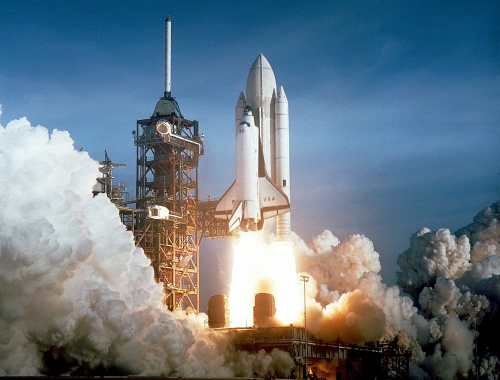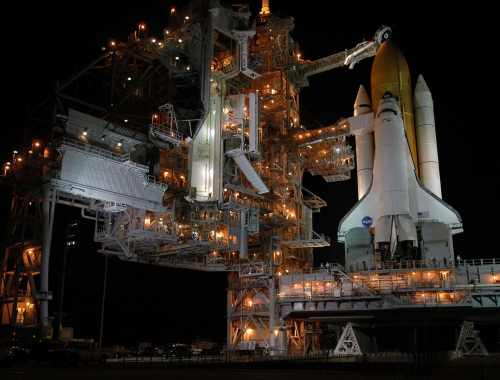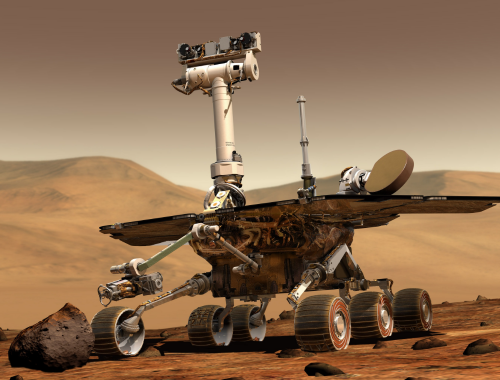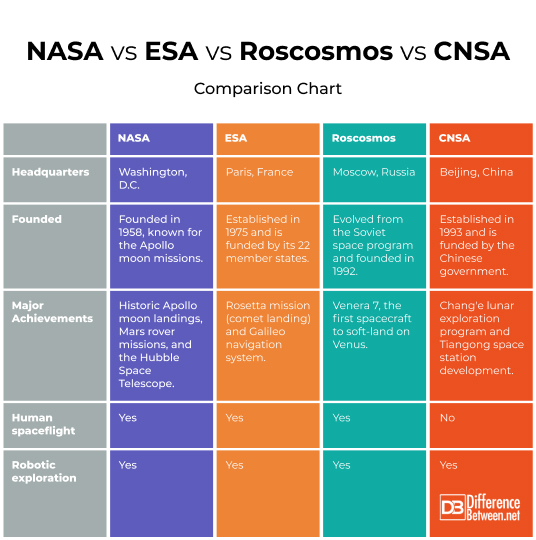Difference Between NASA, ESA, Roscosmos, and CNSA
Space agencies around the world play a pivotal role in the exploration and study of space. They conduct scientific research, explore the cosmos, monitor Earth’s environment, and develop cutting-edge technology. These are organizations established by the governments of countries to engage in activities that are focused on space. Now, some of the major space agencies in the world include NASA, ESA, Roscosmos, and CNSA.
In this article, we’ll talk about each one of them in brief and learn which one is more powerful or capable than others.

NASA
The National Aeronautics and Space Administration, better known as NASA, is the United States’ space agency known for its extensive space exploration missions. NASA has a rich history and still plays a crucial role in uncovering the mysteries of the universe. It was established in 1958 and has since been involved in several historic missions, including the Apollo moon missions and the Mars rover missions.

ESA
The European Space Agency, also known as ESA, is an inherently international agency with 22 member states. Founded in 1975, ESA collaborates with multiple European countries to develop and launch spacecraft and conduct scientific missions. Headquartered in Paris, ESA is dedicated to space exploration and research in Europe.

Roscosmos
The State Space Corporation “Roscosmos” is the space agency of Russia that is responsible for managing Russian space programs. It traces its origins to the Soviet space program, which achieved significant milestones such as launching the first artificial satellite, Sputnik, in 1957. Roscosmos continues to be a major player in space exploration and is involved in both crewed and robotic missions.

CNSA
The China National Space Administration, or CNSA, is a space organization of the People’s Republic of China that is responsible for the planning and development of space activities. Established in 1993, CNSA has rapidly grown and achieved significant milestones, including the Chang’e lunar exploration program and the Tiangong space station. China has become a major player in space exploration in recent years.
Difference between NASA, ESA, Roscosmos, and CNSA
Establishment and History
– Founded in 1958, NASA is the oldest and most well-funded space agency. ESA was founded in 1975 and is funded by its 22 member states. Roscosmos originated from the Soviet space program and was founded in 1992 by a decree of President Yeltsin. CNSA was established in 1993 and is funded by the Chinese government.
Humans to the Moon
– NASA is the only space agency that has successfully conducted crewed missions and sent humans to the Moon. ESA and Roscosmos have both sent humans to the International Space Station (ISS). CNSA is currently developing its own crewed spacecraft, the Shenzhou, to support its China Manned Space Program.
Major Achievements
– NASA, ESA, and Roscosmos have all sent robotic spacecraft to explore other planets. NASA’s most famous robotic spacecraft is the Curiosity rover, which is currently exploring Mars. ESA’s most famous robotic spacecraft is the Rosetta probe, which landed a lander on a comet. Roscosmos’s most famous robotic spacecraft is the Venera 7, which was the first spacecraft to soft-land on another planet.
International Cooperation
– In addition to being a founding member of the ISS, NASA has taken part in numerous other international space initiatives. ESA has worked with NASA on numerous projects and is a significant player in the ISS. Roscosmos has worked with NASA on the ISS, but recent years have seen a decline in its relationships with foreign space organizations. CNSA has only recently started taking part in global space programs.
Future Projects
– NASA’s next big project is the Artemis Program, which will return astronauts to the surface of the Moon by 2024. NASA’s other projects include sending humans to Mars and developing new technologies for space exploration. ESA’s future projects include studying the moon, the sun, and the planets.
Roscosmos’s future missions include maintaining the ISS, developing new crewed spacecraft, and exploring the Moon. CNSA’s current priorities include developing its own crewed spacecraft, exploring the Moon, and studying Mars.
NASA vs. ESA vs. Roscosmos vs. CNSA: Comparison Chart

Summary
These are just some of the major differences between NASA, ESA, Roscosmos, and CNSA. Each space agency has its own unique history, goals, and priorities. These agencies showcase diverse strengths and contributions to space exploration, with each having a unique focus and history. We hope this article has been a valuable resource and covered everything you’d have hoped for.
FAQs
What are the four different space agencies?
The four different space agencies mentioned are NASA, ESA, Roscosmos, and CNSA.
What are the 6 largest space agencies in the world?
The six largest space agencies in the world, in no particular order, include NASA (U.S.), Roscosmos (Russia), CNSA (China), ESA (Europe), ISRO (India), and JAXA (Japan).
Which is the No. 3 space agency?
The No. 3 space agency in the world is the CNSA (China National Space Administration), with an annual budget of US$8.9 billion (as of 2020).
Which is better, NASA or ESA?
NASA is a 100% American organization, and it completely relies on its own resources. The ESA has 22 member states, and it closely collaborates with Russia, one of the major space organizations in the world.
What is the Chinese equivalent of NASA?
The Chinese equivalent of NASA is the CNSA (China National Space Administration).
- Difference Between Caucus and Primary - June 18, 2024
- Difference Between PPO and POS - May 30, 2024
- Difference Between RFID and NFC - May 28, 2024
Search DifferenceBetween.net :
Leave a Response
References :
[0]Petersen, Carolyn Collins. Space Exploration: Past, Present, Future. Amberley Publishing Limited, 2017.
[1]Bizony, Piers. NASA Space Shuttle: 40th Anniversary. Motorbooks International, 2021.
[2]Bonnet, Roger-M., and Vittorio Manno. International Cooperation in Space: The Example of the European Space Agency. Harvard University Press, 1994.
[3]Hamilton, Adrian. Diagram of a Spaceflight. AuthorHouse, 2023.
[4]Thorpe, Emma. “ESA Vs NASA: Comparing the Agencies’ Contribution to Space Exploration.” Orbital Today, 12 Nov. 2022, orbitaltoday.com/2022/03/04/esa-vs-nasa-comparing-the-agencies-contribution-to-space-exploration/.
[5]Image credit: https://www.canva.com/photos/MAC4b4gkum0-first-space-shuttle-launch-on-april-12-1981-astronauts-john-young-and-robert-crippen-spent-54-hours-in-earth-orbit-and-return-in-an-unpowered-landing-at-edwards-air-force-base-in-california-/
[6]Image credit: https://www.canva.com/photos/MADQ5g6dpcs/
[7]Image credit: https://www.canva.com/photos/MADQ5iny5tQ/
[8]Image credit: https://www.canva.com/photos/MAEe0nrGaXU-robot-on-mars/
